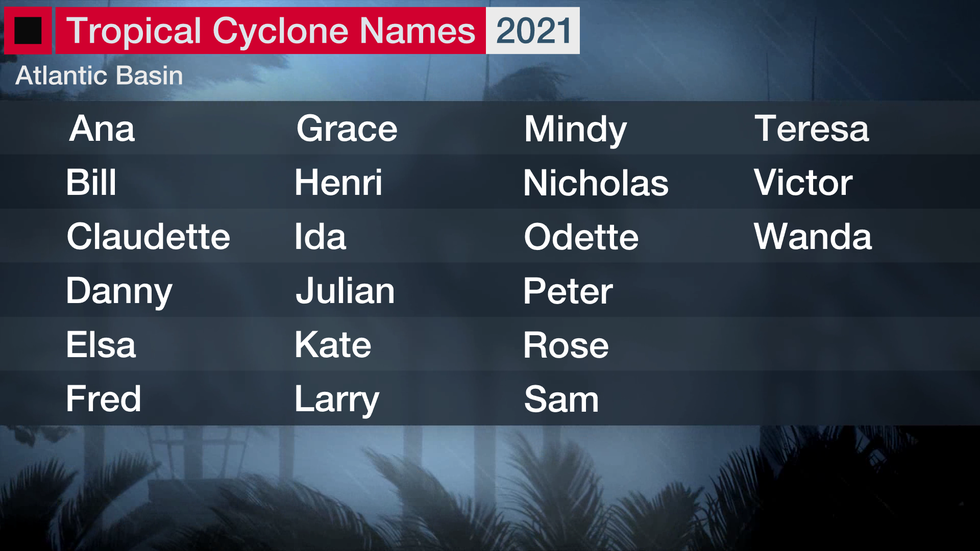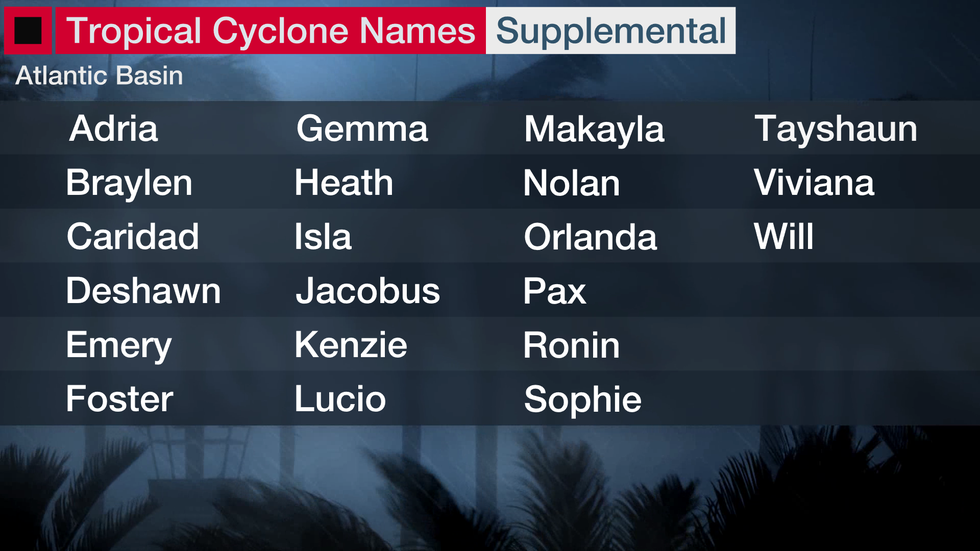Jonathan Belles

With the 2021 Atlantic hurricane season about to begin, here's a look at the names you'll see this year.
Ana - Ana is the only name on the list that has never been tied to a hurricane despite the name being used for seven different storms. 2015's Ana, the most recent use of the name, was the earliest tropical storm to make landfall in the United States. It produced beneficial rainfall and gusty winds in the Carolinas.
Bill - Bill has been used for four tropical cyclones since its inception in 1997, when it replaced Bob. In 2003, the storm that was named Bob produced moderate rainfall over the Southeast and dozens of tornadoes after making landfall in Louisiana.
Claudette - This might be the most recognizable name on this year's list. Claudette has been used seven times dating back to 1979. The original Claudette back in 1979 caused major flooding in southeast Texas and held the record for the wettest 24-hour period for any spot in the U.S. for nearly four decades. The strongest Claudette, 1991's iteration, reached Category 4 status and was also the strongest hurricane of that season.
Danny - Danny has been used six times since it replaced David in 1985. Its most notable version, which happened in 1997, dropped three feet of rain in southern Alabama before sweeping through the Southeast and into the Northeast with rain and gusty winds. Danny killed nine people.
Elsa - This is the first new name on the list this year despite the name being well-known since a certain Disney movie popularized it in 2013. It replaces Erika, which was retired after the 2015 season. Like the cold, let's hope that this storm won't bother us anyway.
Shop Casper's HUGE Mattress Sale (SPONSORED)
Fred - Its two uses so far have both been on hurricanes that formed really far east. In fact, 2015's Fred was the easternmost hurricane to form. Cabo Verde was put under its first-ever hurricane warning. The storm caused heavy rain, deadly seas and gusty winds for the archipelago and the west African coast.
Grace - Grace is one of the most frequently used names around the globe for tropical cyclones. It has been used 18 times around the world, including five tropical cyclones in the Atlantic. This basin's most well-known Grace was better known as the Perfect Storm, which hammered the U.S. East Coast in 1991.
Henri - The most notable Henri was in 2003. That tropical storm dropped moderate rainfall in Florida and the mid-Atlantic. The name has only been used five times since 1979 since the "H" name was not reached in 1997. In 1991, the Perfect Storm nearly became named Henri, but the storm was never named due to the thought that another name would add confusion.
Ida - Another very common name for global tropical cyclones. Eighteen cyclones have been given this name, including two in the Atlantic. One of those two storms gained a slightly different moniker during its lifespan: Nor'Ida. After striking Central America as a hurricane, 2009's Ida became more winter-like and then contributed its energy to a new nor'easter. Nor'Ida became more impactful than the storm when it was fully tropical along the northern Gulf Coast. The nor'easter was responsible for flooding, coastal storm surge and erosion, and gusty winds from the Carolinas to the mid-Atlantic.
Julian - This is the second newcomer to this year's list after Joaquin was retired in 2015 due to its destruction in the Bahamas.
Kate - Kate has been used three times since 1985, but its first use remains the most noteworthy. Kate struck the Florida Panhandle historically late in the season, crossing the Mexico Beach coast in mid-November as a Category 2 hurricane. Kate caused widespread wind damage and power outages across the Florida Panhandle before causing wind and flood damage to much of southern Georgia.
Larry - 2003's Larry, the only storm to receive that name, made landfall in southern Mexico twice, exacerbating an already wet hurricane season for that country. Larry was one of eight storms to make landfall in Mexico that year. It caused flooding and wind damage along southern Mexico's Tehuantepec Isthmus.
Mindy - Also in 2003, Mindy's only iteration caused some flooding in the northern Lesser Antilles.
Nicholas - The 14th named storm in 2003, Nicholas was largely a "fish" storm that never impacted land, although its remnants brought rain and gusty winds to Florida.
Get Best Selling Father's Day Gifts at LuluLemon (SPONSORED)
Odette - The 2003 season kept marching on into December, this time forming into a deep southern postseason tropical storm near Central America. The storm resulted in heavy rain from Costa Rica and Panama to Hispaniola and Puerto Rico as the storm moved northeastward through the Caribbean.
Peter - The 2003 season finally ended in the second week of December with Peter, a fish storm in the northeastern Atlantic that never impacted land.
Rose - This name has never been used in the Atlantic but was at one time a common name in the western Pacific for tropical storms and typhoons.
Sam - This name has never been used in the Atlantic.
Teresa - This name has never been used in the Atlantic.
Victor - This name has never been used in the Atlantic.
Wanda - This name has never been used in the Atlantic but was at one time a common name in the western Pacific for tropical storms and typhoons.
And if we get through the list above, for the first time, a new supplemental will be used this year:
 These names will only be used if more than 21 storms are named this year.
These names will only be used if more than 21 storms are named this year.The Weather Company’s primary journalistic mission is to report on breaking weather news, the environment and the importance of science to our lives. This story does not necessarily represent the position of our parent company, IBM.
The Weather Company’s primary journalistic mission is to report on breaking weather news, the environment and the importance of science to our lives. This story does not necessarily represent the position of our parent company, IBM.

No comments:
Post a Comment